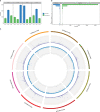Biological and genomic analysis of a symbiotic nitrogen fixation defective mutant in Medicago truncatula
- PMID: 37457346
- PMCID: PMC10345209
- DOI: 10.3389/fpls.2023.1209664
Biological and genomic analysis of a symbiotic nitrogen fixation defective mutant in Medicago truncatula
Abstract
Medicago truncatula has been selected as one of the model legume species for gene functional studies. To elucidate the functions of the very large number of genes present in plant genomes, genetic mutant resources are very useful and necessary tools. Fast Neutron (FN) mutagenesis is effective in inducing deletion mutations in genomes of diverse species. Through this method, we have generated a large mutant resource in M. truncatula. This mutant resources have been used to screen for different mutant using a forward genetics methods. We have isolated and identified a large amount of symbiotic nitrogen fixation (SNF) deficiency mutants. Here, we describe the detail procedures that are being used to characterize symbiotic mutants in M. truncatula. In recent years, whole genome sequencing has been used to speed up and scale up the deletion identification in the mutant. Using this method, we have successfully isolated a SNF defective mutant FN007 and identified that it has a large segment deletion on chromosome 3. The causal deletion in the mutant was confirmed by tail PCR amplication and sequencing. Our results illustrate the utility of whole genome sequencing analysis in the characterization of FN induced deletion mutants for gene discovery and functional studies in the M. truncatula. It is expected to improve our understanding of molecular mechanisms underlying symbiotic nitrogen fixation in legume plants to a great extent.
Keywords: Medicago truncatula (barrel medic); legume; nodule development; symbiotic nitrogen fixation (SNF); whole genome sequencing (WGS).
Copyright © 2023 Shen, Ma, Li, Kang, Pei, Zhang, Tao, Huang, Song, Li, Huang, Wang and Chen.
Conflict of interest statement
The authors declare that the research was conducted in the absence of any commercial or financial relationships that could be construed as a potential conflict of interest.
Figures












Similar articles
-
Rapid identification of causative insertions underlying Medicago truncatula Tnt1 mutants defective in symbiotic nitrogen fixation from a forward genetic screen by whole genome sequencing.BMC Genomics. 2016 Feb 27;17:141. doi: 10.1186/s12864-016-2452-5. BMC Genomics. 2016. PMID: 26920390 Free PMC article.
-
Physical Mutagenesis in Medicago truncatula Using Fast Neutron Bombardment (FNB) for Symbiosis and Developmental Biology Studies.Methods Mol Biol. 2018;1822:61-69. doi: 10.1007/978-1-4939-8633-0_4. Methods Mol Biol. 2018. PMID: 30043296
-
Medicago truncatula resources to study legume biology and symbiotic nitrogen fixation.Fundam Res. 2022 Jul 16;3(2):219-224. doi: 10.1016/j.fmre.2022.06.018. eCollection 2023 Mar. Fundam Res. 2022. PMID: 38932916 Free PMC article. Review.
-
A Medicago truncatula tobacco retrotransposon insertion mutant collection with defects in nodule development and symbiotic nitrogen fixation.Plant Physiol. 2012 Aug;159(4):1686-99. doi: 10.1104/pp.112.197061. Epub 2012 Jun 7. Plant Physiol. 2012. PMID: 22679222 Free PMC article.
-
Model Legumes: Functional Genomics Tools in Medicago truncatula.Methods Mol Biol. 2018;1822:11-37. doi: 10.1007/978-1-4939-8633-0_2. Methods Mol Biol. 2018. PMID: 30043294 Review.
Cited by
-
Novel 4-Chromanone-Derived Compounds as Plant Immunity Inducers against CMV Disease in Passiflora spp. (Passion Fruit).Molecules. 2024 Feb 28;29(5):1045. doi: 10.3390/molecules29051045. Molecules. 2024. PMID: 38474557 Free PMC article.
References
-
- Alonso J. M., Stepanova A. N., Solano R., Wisman E., Ferrari S., Ausubel F. M., et al. . (2003). Five components of the ethylene-response pathway identified in a screen for weak ethylene-insensitive mutants in arabidopsis. Proc. Natl. Acad. Sci. U S A. 100 (5), 2992–2997. doi: 10.1073/pnas.0438070100 - DOI - PMC - PubMed
-
- Barker D., Bianchi S., Blondon F., Dattee Y., Duc G., Essad S., et al. . (1990). Medicago truncatula, a model plant for studying the molecular genetics of the rhizobium-legume symbiosis. Plant Mol. Biol. Rep. 8, 40–49. doi: 10.1007/BF02668879 - DOI
LinkOut - more resources
Full Text Sources
Miscellaneous

